Nikephoros I › Prometheus Bound › Battle of Manzikert » Origins and History
Articles and Definitions › Contents
- Nikephoros I › Who Was
- Prometheus Bound › Origins
- Battle of Manzikert › Origins
Ancient civilizations › Historical places, and their characters
Nikephoros I › Who Was
Definition and Origins
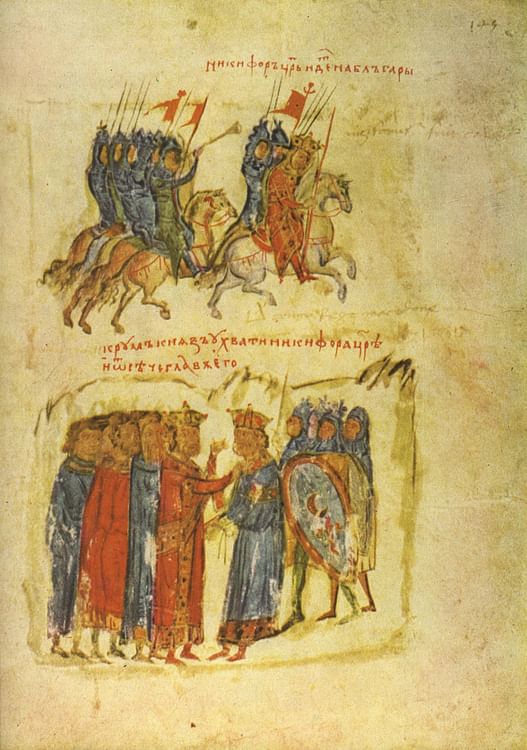
Nikephoros I ruled as emperor of the Byzantine Empire from 802 to 811 CE. A former finance minister who did much to improve the state economy, Nikephoros was not particularly popular with the empire ’s overtaxed peasants and overregulated merchants. Initially successful in his foreign affairs when he won victories in the Balkans, he then faced a rebellion in Asia Minor in 806 CE and subsequent losses to the Abbasid Caliphate. The emperor was killed on the battlefield fighting in Bulgaria, and his skull was infamously made into a silver -lined drinking cup by his nemesis the Bulgar Khan Krum.
SUCCESSION
Irene the Athenian (r. 797-802 CE) had been the first-ever woman to rule as Byzantine emperor in her own right. The wife of Leo IV (r. 775-780 CE) and regent for her young son Constantine VI from 780-790 CE, Irene took sole power in 797 CE after enduring the ignominy of exile following her insistence she should rule above her son no matter what age he reached.However, her proposed marriage alliance with Charlemagne, king of the Franks and Emperor of the Romans in the west, was a step too far for the Byzantine establishment and she was deposed and exiled for the second time in October 802 CE.Nikephoros, the chief finance minister ( logothetes tou genikou ) under Irene, was selected as the new emperor.
DOMESTIC POLICIES
Perhaps unsurprisingly, given his former ministerial role, Nikephoros quickly set about putting the Byzantine economy on a sounder footing after the chaotic years of Irene's reign. For some time the state coffers had been less full than they ought to have been because of inefficiencies in tax collection and Irene giving out too many tax privileges to all and sundry. Accordingly, the tax rolls were reassessed and new land taxes imposed. There was a new tax, the hearth tax ( kapnikon ), which was payable by all peasant tenants who worked on land owned by churches and monasteries. Another burden was the obligation of all villages to finance the military arms and equipment of those community members who could not afford to do so themselves. The village was also expected to pay the tax arrears of its poorer inhabitants, too.
THE EMPEROR'S TAX REFORMS DID ACHIEVE THEIR AIM & THE STATE WAS IN A MUCH HEALTHIER FINANCIAL SITUATION THAN UNDER HIS PREDECESSORS.
Other taxes included duties on imported goods, notably on slaves bought from outside the empire. The duties were relatively easy to collect as the state controlled most of the access points open to merchants. Traders were also hit by a ban on private loans, and shipowners could only raise money through the state, which charged 17% interest (the usual being below 6%).Finally, a tax on inheritance was introduced. It seemed that having an accountant as an emperor had its consequences.
As one might expect, Nikephoros' taxes were not very popular, especially with the Church who not only suffering under them itself also saw them as an unnecessary burden on an already impoverished peasantry. Monasteries were targeted, especially, and their property was often confiscated or they were compelled to host army units unpaid. One of the chief voices in the protests was Theophanes the Confessor (dc 818 CE) who wrote his Chronographia history on the period, which predictably, contains an unflattering section on Nikephoros' reign.

Gold Coin of Nikephoros I
The Church was not pleased with the emperor's choice for the important position of Patriarch (bishop) of Constantinopleeither. Confusingly selecting his namesake, the scholarly layman Nikephoros I (r. 806-815 CE), the new bishop's support of the second marriage of Constantine VI (r. 780-797 CE) in 795 CE, which had created the Moechian controversy over whether an emperor should remarry, set off yet another round of heated debate and conflict between elements of the Church and the emperor. Nikephoros the bishop had called a synod of clerics and laymen in 806 CE, which recognised the marriage and pardoned Joseph, the priest who had performed the ceremony. Especially unhappy were the monks and followers of Theodore of Stoudios, who had been persecuted for opposing the marriage at the time. The issue would only be resolved when emperor Michael I (r. 811-813 CE) exiled Joseph and recalled Theodore and his followers from exile in 811 CE.
Still, despite these controversies, the emperor's tax reforms did achieve their aim and the state was in a much healthier financial situation than under his predecessors. The army and navy could be paid for and expanded, and the fortifications of Constantinople could be improved too. The empire was further bolstered by the movement of loyal settlers from Asia Minor to Greece, improved defences in Greece and the creation of new military provinces ( themes ) across the Balkans. These provinces were Thrace, Macedonia, Kephalonia, Dyrrachium, and Thessalonike, with Thessalonica as its capital.
FOREIGN POLICY
Having improved the military muscle at his disposal, Nikephoros set about using it to good effect. Victories came against the Slavs in the Peloponnese and Serdica region of Bulgaria. A minor skirmish with Charlemagne and the Franks over Venice was settled by a peace treaty in 807 CE, although another naval encounter occurred in 810 CE when the doge Oblerius proved disloyal to Byzantine rule.

The Byzantine Empire in the mid-9th century CE
The Bulgars, unified and led by their charismatic Khan Krum (rc 802-814 CE) were now proving particularly troublesome. In 808 CE Krum wiped out a Byzantine army near the river Strymon, and in 809 CE he did the same to the Byzantine garrison at Sofia. He also managed to seize the treasure chest of the army containing 80,000 gold coins. Nikephoros responded admirably to these blows by assembling a large revenge force and sacking the Bulgar capital at Pliska in 810 CE, and again in 811 CE when men, women, and children were mercilessly butchered. The fortress at Sofia was also rebuilt.
A CONSEQUENCE OF THE TOURKOS REVOLT WAS THAT IT WEAKENED BYZANTINE CONTROL OF ASIA MINOR.
Elsewhere was a different story, though. In 803 CE a serious revolt was led by Bardanes Tourkos, a military commander of five provinces in Asia Minor. The revolt only lasted a month and ended when some commanders switched their support back to the emperor and Bardanes Tourkos retired to a monastery.
A consequence of the Tourkos revolt was that it weakened Byzantine control of Asia Minor, a situation fully exploited by Harun al-Rashid (r. 789-809 CE), leader of the Abbasid Caliphate based in Baghdad, who seized Tyana and Herakleia at the Cilician Gates in 806 CE. A peace between the two states was only achieved in 807 CE and that at the cost of a hefty tribute from Nikephoros to his rival: 30,000 gold nomisma coins per annum.

Khan Krum of the Bulgars
Even more disastrous was the ongoing campaign against the Bulgars. After the resounding successes mentioned above the fortunes of the Byzantines nose-dived spectacularly. Nikephoros and his army were ambushed near Pliska on 25 July 811 CE.The Bulgars had waited until dark and then, using wooden palisades, blocked both the entrance and exit to a narrow mountain pass in which the Byzantines had camped for the night. The next morning the Byzantine army was trapped and all but wiped out by sword, fire and landslides set off by the Bulgars. Many of the top Byzantine generals were killed in the disaster, and even those few cavalry that managed to escape the debacle were pursued until they fell into a ravine and drowned in the river below.
Most calamitous of all, Nikephoros was killed in the battle, the first Byzantine ruler to suffer such a fate at the hands of foreigners for over 400 years. His body was identified by its purple boots and brought before Krum who had the head cut off and placed on a spike for a few days. Infamously, Krum then had Nikephoros' skull inlaid with silver and converted into a drinking cup which he and his allies used to toast their victory. The Bulgar leader was even said to have kept his souvenir and to have forced visiting ambassadors from Constantinople to drink from it whenever the opportunity arose.
SUCCESSORS
In 811 CE Nikephoros was succeeded by his son and heir Staurakios (aka Stavrakios). Unfortunately for the empire, Staurakios had been seriously wounded in the very same battle in which his father had been killed. The young emperor succumbed to his wounds only two months after inheriting his title. Next to step up was Michael I Rangabe, husband of Staurakios' sister Prokopia and who was backed by the Patriarch Nikephoros, but he would only last two years. In that brief time, the emperor did manage a peace with Charlemagne in the west and a return of Byzantine possessions on the Adriatic coast. Once more, though, the troublesome Bulgars were responsible for an imperial change when they defeated Michael's army in 813 CE. Obliged to abdicate after the debacle, Leo V the Armenian, a prominent general, then took the throne in the same year. He would bring a measure of much-needed stability and reign until 820 CE.
Prometheus Bound › Origins
Definition and Origins
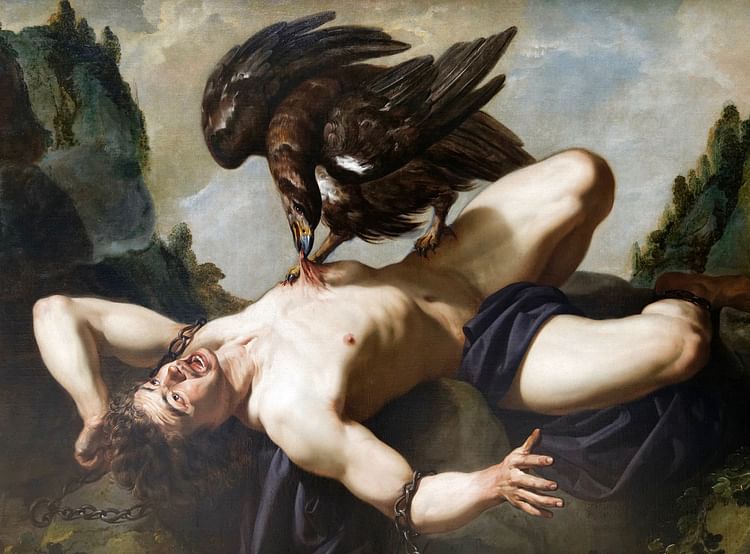
The Greek dramatist Aeschylus (c. 525 - c. 456 BCE) is considered one of the greatest tragic playwrights of his generation.He is often referred to as the “Father of Greek Tragedy.” Older than both Sophocles and Euripides, he was the most popular and influential of all tragedians of his era. Aeschylus authored over 90 plays; both tragedies and satyrs. Unfortunately, aside from a few fragments, only six complete plays have survived. Among his most famous remaining works are The Persians, Seven against Thebes, and Agamemnon, part of the Oresteia trilogy. A seventh surviving play Prometheus Bound is the subject of some dispute. As part of a trilogy together with Prometheus Unbound and Prometheus Firebringer, it was written around the time of Aeschylus' death; however, some scholars claim it was actually written by someone else, possibly his son Euphorion.
AESCHYLUS, THE FATHER OF GREEK TRAGEDY
Aeschylus was born to an aristocratic family in 520 BCE near Athens in the town of Eleusis. Although he performed and composed some of his plays in Sicily, he would live his entire life in Athens. Little is known of his wife and family; however, both of his sons, Euphorion and Euaion were playwrights. According to classicist E. Hamilton, he was profoundly religious but somewhat radical, pushing aside the trappings of traditional Greek religion. The gods in his plays are seen as shadows, “questioning how a god can be considered just when people are allowed to suffer.” (193) For example, in Prometheus BoundZeus is portrayed as a tyrant. This was the exact opposite of Hesiod ’s Zeus where he is depicted as a god of justice.Politically, Aeschylus was a strong supporter of Athenian democracy, a lover of freedom and justice. He fought against the Persians at Marathon in 490 BCE and at Salamis in 480 BCE. It was not until the early 490s that he began to write, participating in his first competition in 499 BCE, and finally winning his first victory in 484 BCE. Eventually, he won a total of 13 first-place victories, second only to Sophocles. He would continue to write until his death.

Aeschylus
Like his contemporaries, his plays were often composed for competitions at various rituals and festivals and performed in outdoor theaters. The purpose of these tragedies was to not only entertain but also to educate the Greek citizen, to explore a political, social, or ethical problem. Along with a chorus of singers to explain the action, there were actors who wore masks and costumes. As with Aeschylus' Prometheus Bound and Sophocles' Oedipus the King, the audience was usually well aware of the story behind the play.
According to translator and editor, D. Grene, Aeschylus played a major role in “developing tragedy to its pinnacle of dramatic sophistication and moral power.” (2) Prior to Aeschylus, a play's dialogue was hampered with only one actor. With the introduction of a second actor, plot construction was given more freedom. Likewise, the intricacy and subtlety of plays increased. Unlike Sophocles and others, Aeschylus designed costumes, trained his choruses, and may have even acted in some of his own plays.
MAIN CHARACTERS & THE MYTH
THE FOCUS OF THE PLAY IS THE BATTLE BETWEEN THE SUPREME POWER OF ZEUS & THE STUBBORN RESOLVE OF PROMETHEUS.
Prometheus Bound ’s cast of characters is few: the Titan Prometheus, Hephaestus, Ocean, Io, Hermes, Might, Violence (non-speaking), and, of course, the chorus. It tells of the plight of the Greek god Prometheus, son of the god Themis. The focus of the play is the battle between the supreme power of Zeus and the stubborn resolve of Prometheus. Prometheus had one fatal flaw and, for this, he would be tormented: he loved humans, and to save them from the wrath of Zeus, he stole fire, incurring the vengeance of the Olympian god. So, in a fit of anger, Zeus ordered Prometheus chained to a remote precipice where an eagle would come every night to feast on his liver. Throughout the play, he speaks to the chorus on his plight, defending why he had given mankind fire. He declares that through his gift of prophecy he sees a future that will bring the downfall of Zeus. At the end of the play, Prometheus is visited by the messenger of the gods, Hermes, who asks about the future he has foreseen and the fate of Zeus. Somewhat arrogantly, Prometheus refuses to tell and, in the closing of the play, is struck by the wrath of Zeus.
THE PLOT
The play begins at a desolate crag in the Caucasus Mountains. A henchman of Zeus, Might, speaks to Hephaestus, the god of fire: “It's your job, now, Hephaestus, to carry out the commands the Father laid on you, to nail this malefactor to the high craggy rocks in fetters unbreakable of adamantine chain” (Grene, 173). But Hephaestus is reluctant and says he does not have the heart to do it, apologizing to Prometheus, warning him that he will neither hear nor see anyone and be burned by the sun's rays. He adds that nothing to say will change things, for “… the mind of Zeus is hard to soften with prayer, and every ruler's harsh whose rule is new” (174).
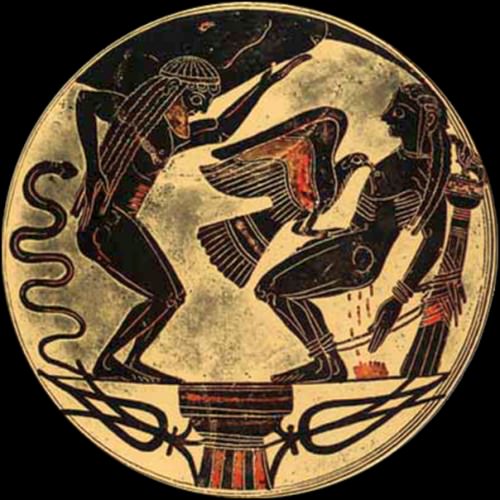
Prometheus & Atlas
Might taunts Prometheus, saying the gods made a mistake when they called him "Forethought". He asks him what kind of help his mortals can offer to save him now. However, Prometheus stays strong defending what he had done for mankind, saying he will bear what fate has given him. Alone, he speaks out loud of his gift of fire to mankind:
I hunted out the secret spring of fire that filled the fennel stalk, which when revealed became the teacher of each craft to men, a great resource. (178)
This was the crime for which he is being punished. Speaking to the chorus, he laments, wondering why he had not been cast down into Hades instead. Bound to the crag, he is now the plaything of the winds. His enemies will be able to laugh at his suffering. However, he cries out that Zeus is savage and keeps justice according to his own standards. However, down deep, Prometheus knows that Zeus will one day be broken and come to him.
The chorus admonishes Prometheus, saying he speaks too freely. They continue, asking Prometheus to tell the story behind Zeus' punishment – why is he to be punished “so cruelly with such dishonor.” The Titan speaks of how he had followed his mother's advice and helped Zeus overthrow his fellow Titans; however, after ascending the throne, Zeus awarded each god with their “several privileges” but to humanity he gave nothing, intending on blotting them out.
The chorus admonishes Prometheus, saying he speaks too freely. They continue, asking Prometheus to tell the story behind Zeus' punishment – why is he to be punished “so cruelly with such dishonor.” The Titan speaks of how he had followed his mother's advice and helped Zeus overthrow his fellow Titans; however, after ascending the throne, Zeus awarded each god with their “several privileges” but to humanity he gave nothing, intending on blotting them out.
I rescued men from shattering destruction that would have carried them to Hades' house and therefore I am tortured on this rock. (183)
He had felt pity for mortals but found none for himself. The chorus leader responds that his own heart was now pained. Riding in on a sea monster, the god Ocean gazes at Prometheus' plight, telling how he shared in the god's pains and wondered how he could be of help. Somewhat defensively, Prometheus questions if he was there to stare at his misfortune or offer pity.Ocean begs him to be silent, for if he continues to speak out, Zeus will hear and bring more pain. He begs him to “… give up this angry mood of yours and look for ways of freeing yourself from these troubles.” (187) Ocean says he will make a plea to Zeus to free Prometheus from his torment, but Prometheus responds, telling him not to bother. He adds that just because he is unlucky he does not want anyone else to be unlucky as well. He says that his heart was already sore. Prometheus relates the plight of his brother Atlas who supports the earth on his shoulders. He tells Ocean that he will bear the pain that Zeus has given him until the “mind of Zeus shall ease from anger.” He warns Ocean to be careful and that speaking to Zeus would be useless. With that, Ocean leaves.
Prometheus turns to the chorus and speaks of his kindness to mortals. He had found them mindless and made them intelligent, “masters of their own minds.” They had eyes but did not see any purpose; they had ears but could not hear.Speaking to the chorus he boasts that all human arts came from him.

Prometheus Creating Man
With horns like an ox on her head, Io arrives. She asks Prometheus if he can hear the voice of the one-horned girl.Prometheus greets her and relates how the Zeus' desire for her made him turn her into a cow to avoid the wrath of his wife, Hera. Now she is haunted by a never-ending gadfly sent by Hera to punish her. She asks him why he is being punished. He replies that he was done telling that tale. Simply put, he is the giver of fire to man. Instead of speaking of his own dilemma, he asks her of her plight. She replies,
Why do I not throw myself at one from this rough crag to strike the ground and find release from all my troubles.(202)
Prometheus informs her that he will be released from his own problem when Zeus falls from power. Io asks how this will happen. Prometheus answers that Zeus will make a marriage that he will regret. His wife (it will not be Hera) will bear a son that will be mightier than his father. And, this person will be a descendant of Io. Prometheus gives her instructions: she is to go to Egypt where Zeus will restore her mind and touch with a hand that “brings you no fear.” In future generations, a descendant of that child will overthrow his father, Zeus. To the chorus, Prometheus speaks:
Yet shall this Zeus, for all his arrogance, be humble yet, such is the match he plans, a union that shall drive him from his power and from his throne… (209)
After Io leaves, Prometheus declares aloud that only he can tell Zeus how to avoid his destiny. Prometheus would not be alone for long. He is joined by the messenger of the gods, Hermes. Zeus has learned of the prophecy, but when Hermes asks, Prometheus refuses to speak of it. Hermes tells Prometheus that his attitude is what got him his present condition.Prometheus says that there is nothing Zeus can do to change his mind until “these atrocious shackles have loosed.” Hermes informs Prometheus of Zeus' curse upon him - to have an eagle come each night to eat his liver. Hermes adds that the proud Prometheus must heed the warning and not to blame Zeus but himself for what the future may bring. As Hermes leaves, there is thunder and lightning in the background. Prometheus ends the play saying,
Such is the storm that comes against me plainly from Zeus to work its sorrows. O holy Mother, O Sky that circling brings light to all, you see how unjustly I suffer. (216)
LEGACY
Few would doubt that Aeschylus had a profound effect on Greek tragedy as an art form. He was the most influential and innovative tragedian of his generation. Prior to him, plays were limited; with only one actor and the chorus, interaction between characters was impossible. This limited conversation with an actor only speaking only to the chorus. With the addition of a second actor by Aeschylus, conversation between performers was now possible. This major change allowed for an increase in dramatic tension and plot development. After his death, his son, playwright Euphorion, restaged many of his plays. The Athenians respected his work so much that they passed a special decree allowing his plays to be performed annually at rituals and festivals. According to Grene, in the 18th and 19th centuries CE intellectuals rediscovered Aeschylus. Attention was given to his religious questioning and presentation of moral and political problems, and his plays are often seen as the foundation of Western drama.
Battle of Manzikert › Origins
Ancient Civilizations
The Battle of Manzikert (Mantzikert) in ancient Armenia in August 1071 CE was one of the greatest defeats suffered by the Byzantine Empire. The victorious Seljuk army captured the Byzantine emperor Romanos IV Diogenes, and, with the empirein disarray as generals squabbled for the throne, nothing could stop them sweeping across Asia Minor. Manzikert was not a terrible defeat in terms of casualties or immediate territorial loss, but as a psychological blow to Byzantine military prowess and the sacred person of the emperor, it would resound for centuries and be held up as the watershed after which the Byzantine Empire fell into a long, slow, and permanent decline.
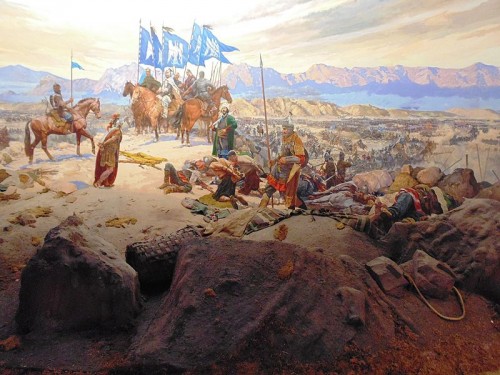
Battle of Manzikert
BYZANTIUM & THE SELJUKS
Romanos IV Diogenes (r. 1068-1071 CE), himself formerly a general, had inherited a Byzantine army in poor shape with inadequate arms and an overreliance on unreliable mercenaries and undisciplined conscripts. His predecessor Constantine X (r. 1059-1067 CE) had purposely expanded the state civil service, invested heavily in renovating Constantinople and completely neglected the army. Even worse, the empire was over-stretched with too many borders to defend. The Seljuks, in particular, were proving troublesome in Asia Minor. This nomadic tribe from the Asian steppe was of Turkish origin, and they had been repeatedly raiding Byzantine outposts, notably sacking Melitene in 1058 CE and Caesarea in 1067 CE. This necessitated the emperor into strengthening the fortresses around Lake Van which protected the routes into the region from Armenia and central Asia. The Byzantine emperor successfully campaigned in the region in 1070 CE, then, in March 1071 CE, he decided for one monumental push to rid Armenia, and anywhere else for that matter, of the Seljuks once and for all.
The Seljuk leader was Alp Arslan (r. 1063-1073 CE) and, along with an empire now covering Iran, Iraq, and most of the Near East, the sultan had at his disposal an army of highly skilled and mobile horsemen. Romanos' army was big, according to some sources it had 300,000 men, although modern historians prefer a figure of 60-70,000, still double that of the Seljuks.Whatever the size, one indisputable fact was that Romanos' army consisted of a hotchpotch of conscripts and mercenaries which included the Pechenegs and Uzes of the Eurasian Steppe, and even a contingent of Normans led by Roussel de Bailleul. The latter figure, an infamous adventurer, was highly suspect in his loyalty to the cause and was really only looking out for a choice kingdom of his own.
WHATEVER THE EXACT CIRCUMSTANCES, THE RESULT WAS THAT ROMANOS WAS LEFT WITH HALF THE ARMY HE HAD STARTED OUT WITH.
PROLOGUE
On arrival in Armenia in August 1071 CE, Romanos split his force into two. One half was sent north of Lake Van under the command of the general Joseph Tarchaniotes. The other half, led by the emperor and his general Nicephorus Bryennius, headed for the small fortress of Manzikert which was taken without much bother. Meanwhile, just what happened to Tarchaniotes is uncertain. Byzantine sources are strangely quiet, and Muslim sources describe a victory for Arslan. The general was experienced, and given the size of his force, it seems unlikely he was wholly defeated. Tarchaniotes may have deserted the cause, perhaps out of loyalty to a rival claimant to the Byzantine throne, or perhaps he even harboured imperial ambitions of his own. Whatever the exact circumstances, the result was that Romanos was left with half the army he had started out with.
BATTLE
The two leaders and their armies finally met on 25 August near Manzikert, and a skirmish followed which resulted in the Byzantines being harassed by the Seljuk bowmen and Nicephorus Byrennius receiving three, albeit superficial, wounds.Almost immediately after the real fighting started, the Normans turned about and fled. Some of the Uzes mercenaries switched sides, too. The sporadic engagements, nevertheless, continued into the second day. Then the Seljuk leader, with his own difficulties to pay his soldiers and, in any case, far more interested in Syria, sent a delegation offering a truce. Romanos rejected it.
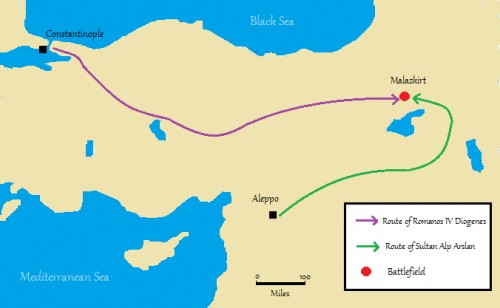
Location Map of the Battle of Manzikert, 1071 CE
Romanos lined up his army for a full-on and decisive confrontation with several rows of infantry, his cavalry on the wings and himself dead centre. The 11th-century CE Byzantine historian Michael Psellos, in his biography of Romanos, criticises the emperor for donning armour like an ordinary soldier and hacking away at the enemy without any concern for his person or his responsibility as overall commander. Arslan, meanwhile, was more circumspect and consistently withdrew his forces in a crescent formation, allowing the Byzantines to advance but at the same time become increasingly exposed to the Seljuk archers who harassed the enemy flanks on horseback. As the light began to fade at the end of the day, Romanos ordered his troops to return to their camp.
Then disaster struck as the Seljuks swept forward against the retreating Byzantine cavalry. In the chaos, a large body of Byzantine troops panicked when they thought the emperor had been killed. The rumour had been started by one of Romanos' rivals, Andronikos Doukas, and the consequence was a disordered collapse of the Byzantine lines, a separation of the Byzantine rearguard from the main body and then encirclement by the Seljuk mounted archers. The left flank of the army tried to come to the aid of Romanos who was being overwhelmed in the centre but were pushed back by the enemy. The defeat was total, and Romanos, his horse killed from under him and with a wound to his sword hand, was captured. An eyewitness, Michael Attaleiates, gives the following vivid description of the debacle:
It was like an earthquake: the shouting, the sweat, the swift rushes of fear, the clouds of dust, and not least the hordes of Turks riding all around us. It was a tragic sight, beyond any mourning or lamenting. What indeed could be more pitiable than to see the entire imperial army in flight, the Emperor defenceless, the whole Roman state overturned - and knowing that the Empire itself was on the verge of collapse? (In Norwich, 240)
ROMANOS' CAPTURE
According to Michael Psellos, the captive emperor was not treated at all badly by Arslan but was released from his chains when identified. After a submissive kiss of the ground before the feet of Arslan, who then placed his boot symbolically on the emperor's neck, Romanos was well fed for a week and even allowed to nominate any of his fellow captives for freedom. The 11th-century CE Scylitzes Chronicle also gives a full account of the capture, including the famous episode in which Arslan asked Romanos what he would have done if the positions had been reversed. Romanos was said to have replied “I'd have flogged you to death” whereupon the Muslim Arslan replied that I “will not imitate you. I have been told that your Christ teaches gentleness and forgiveness of wrong. He resists the proud and gives grace to the humble” (quoted in Psellos, 358). Nothing worse than being captured and preached to.
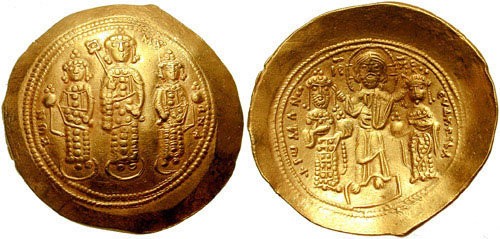
Romanos IV Histamenon
True to his word, though, Arslan released Romanos but only did so after he promised to give a personal ransom to the Seljuk leader, agreed to cede to him Armenia as well as the major cities of Edessa, Hieropolis, and Antioch, and offered one of his daughters to marry a son of the Seljuk leader. There was also the matter of a tribute: first, a one-off payment of 1.5 million gold coins to be followed by a hefty annual tribute of 360,000 gold coins.
AFTERMATH
Unfortunately for Romanos, his joy at freedom was short-lived for when he returned to Constantinople he was deposed and blinded, the throne taken over by a rival general Michael VII Doukas (r. 1071-1078 CE). Although the material losses to the Byzantine army were not huge at Manzikert, there were two lasting effects. One was on the psyche of the Byzantines having lost, albeit temporarily, their emperor. The other was more practical and significant. With Romanos' reputation tainted by the debacle, there was a mad scramble by many commanders in the provinces of Asia Minor to return to Constantinople and claim the throne for themselves. The civil war which ensued and the lack of the army's full support for Michael VII seriously weakened the empire's ability to resist the Seljuks in the longer term. Thus, Arslan and his successors continued to raid Asia Minor at will, establishing the Sultanate of Rum with their capital at Nicaea c. 1078 CE and even capturing Jerusalem in 1087 CE.
1071 CE had proved to be a disastrous year for the Byzantine Empire in more ways than one as, besides Manzikert, Bari was lost to the Norman king Robert Guiscard and Byzantine control in southern Italy was thus finally extinguished. Michale VII's reign would not meet with any more success than his predecessor's. Within the empire, rising prices and political unrest developed into several military rebellions which would eventually oust the emperor. The Byzantines would only see a return to stability and the empire regain some of its former glory with the reign of Alexios I Komnenos from 1081 CE, himself a veteran of the fateful battle at Manzikert.
LICENSE
Article based on information obtained from these sources:with permission from the Website Ancient History Encyclopedia
Content is available under License Creative Commons: Attribution-NonCommercial-ShareAlike 3.0 Unported. CC-BY-NC-SA License